“It is possible to fly without motors, but not
without knowledge and skill."
-Wilbur Wright
Pre-Driving Bioptic Training
Training of the bioptic driver prior to behind-the-wheel training ensures the patient will be confident and prepared in using the system before they face the rigors of in car training. The training process is crucial to producing safe bioptic drivers. Our experience has led to development of a structured training manual to better organize the initial training process prior to behind-the-wheel training. No person should ever drive with bioptics without a detailed and organized training program.
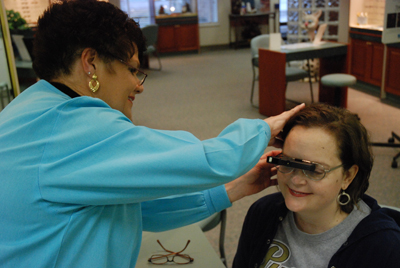 Initial Fitting and Training: The process of bioptic training begins at the dispensing and fitting of the bioptic system. The bioptic is adjusted to provide the appropriate height and angle to be out of the way while using the carrier, but can be quickly introduced by a slight head tilt downward. The bioptic must be angled up slightly to start so that it is straight ahead down the road when patients tilt their heads downward to view through it. The comfort of the system is checked as well. The visual acuity is rechecked to assure the patient‘s vision meets the required state guidelines.
Initial Fitting and Training: The process of bioptic training begins at the dispensing and fitting of the bioptic system. The bioptic is adjusted to provide the appropriate height and angle to be out of the way while using the carrier, but can be quickly introduced by a slight head tilt downward. The bioptic must be angled up slightly to start so that it is straight ahead down the road when patients tilt their heads downward to view through it. The comfort of the system is checked as well. The visual acuity is rechecked to assure the patient‘s vision meets the required state guidelines.
Care and Maintenance of the Bioptic: The patient is instructed in the care and maintenance of the system. Proper techniques for cleaning the system are introduced. Additionally, warnings on excess heat or cold exposure are reviewed.
B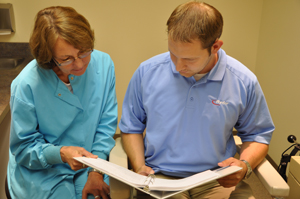 ioptic Training Manual: The training of bioptic drivers is crucial. To that end, our practice has developed a training manual that takes our patients step-by-step through the processes listed below. Our patients are required to keep a detailed log of their training activities. Our training covers those areas needed before the patient enters behind-the-wheel training. We will not release a patient for behind-the-wheel driver's rehabilitation until they have masters our program. This makes them better prepared when they enter the behind-the-wheel driving rehab.
ioptic Training Manual: The training of bioptic drivers is crucial. To that end, our practice has developed a training manual that takes our patients step-by-step through the processes listed below. Our patients are required to keep a detailed log of their training activities. Our training covers those areas needed before the patient enters behind-the-wheel training. We will not release a patient for behind-the-wheel driver's rehabilitation until they have masters our program. This makes them better prepared when they enter the behind-the-wheel driving rehab.
Restrictions, Limitations and Liability Review: The patient is instructed not to drive with the system until licensed by the state. The patient must complete all required training in order to proceed to licensure. The patient is informed that when the bioptic permit issued in Indiana is only for use with the driving rehab specialist. The patient reviews and signs a liability statement that only the BMV can make the final decision on the ability to be licensed.
Potential restrictions are reviewed including issues of weather, sunlight, night driving and traffic volume. These can be modified by the results of the driving rehabilitation specialist. Avoidance of distractions such as cell phones, texting, and passengers is reviewed.
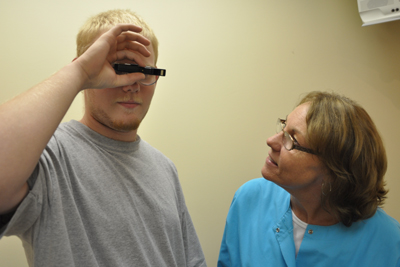 Mechanics of Using the Bioptic System: The patient is instructed in the focusing of the system and in the use of sun filters. The concept of the carrier system versus the telescopic portion is reviewed. The patient is instructed in the basic movements into the bioptic and the importance of spending only a few seconds in the telescope. The “I” movement,straight up and down for quick spotting, and the “U” movement, down and across and up used when stopped to check down the road. Head movements versus eye movements are reviewed.
Mechanics of Using the Bioptic System: The patient is instructed in the focusing of the system and in the use of sun filters. The concept of the carrier system versus the telescopic portion is reviewed. The patient is instructed in the basic movements into the bioptic and the importance of spending only a few seconds in the telescope. The “I” movement,straight up and down for quick spotting, and the “U” movement, down and across and up used when stopped to check down the road. Head movements versus eye movements are reviewed.
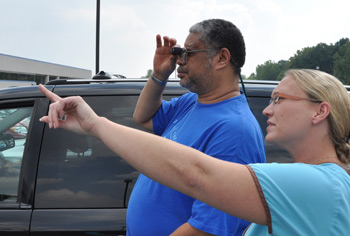
Spatial Relationships in the Telescopic Systems: The visual spatial effects of telescopic magnification are demonstrated. Objects will seem closer at first. The stronger the telescopic magnification power the faster the motion of moving objects will be seen through the telescope. Magnification will initially create the illussion that obects will seem are closer than where they actually are.
Surveillance of the Visual Environment: The ability to spot quickly through the bioptic while still being aware of the overall visual environment is demonstrated. This process has been labeled as multiplexing by Dr. Eli Peli of Harvard University.
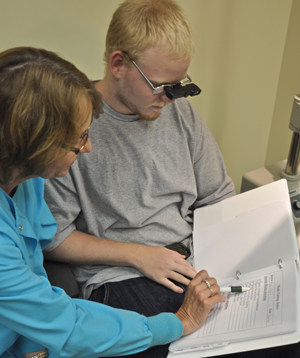 Spotting with the Bioptic System: Patients begin to learn to spot accurately and quickly. Four types of spotting scenarios are practiced. These include first spotting stationary object while stationary and then spotting moving object while stationary. The patient moves on to the spotting of stationary objects while moving and spotting moving objects while moving.
Spotting with the Bioptic System: Patients begin to learn to spot accurately and quickly. Four types of spotting scenarios are practiced. These include first spotting stationary object while stationary and then spotting moving object while stationary. The patient moves on to the spotting of stationary objects while moving and spotting moving objects while moving.
Traffic Sign Training: New drivers must learn the signs they will encounter so that a quick scan is all that is required. Computer CD based training programs are used to practice spotting with the bioptic and simultaneously speed the identification of traffic sign. We want the the patient to recognize traffic sign message in 1 to 1.5 second.
Use of Mirrors: The patient is instructed to use the carrier lenses for most mirror spotting. In rare cases, the bioptic might be used with the mirrors. This can vary with the patient’s visual acuity. Additional mirors can be added to the patient's car to improve functioning.
Descriptive Driving: Spotting ability in the real world in a moving environment can be better refined with descriptive driving. The patient sits on the passenger side wearing the bioptic and reports verbally to the driver what is seen across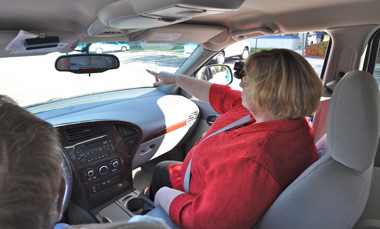 the visual environment. The driver challenges the patient if something is not reported. This training can be done with friends or family members and helps the potential driver detect weaknesses in spotting, glare and visual clutter. If the patient finds glare problems during descriptive driving sessions, additional filters can be prescribed before the patient enters behind-the-wheel training.
the visual environment. The driver challenges the patient if something is not reported. This training can be done with friends or family members and helps the potential driver detect weaknesses in spotting, glare and visual clutter. If the patient finds glare problems during descriptive driving sessions, additional filters can be prescribed before the patient enters behind-the-wheel training.
Descriptive driving also introduces the motion of car and the effects this has on the magnified image through the bioptic. It also helps the patient practice awareness of the whole visual environment. Patients also learn to use their bioptic more frequently at higher speeds and the need to constantly sample the visual environment.
Referral for Behind-the-Wheel Driver Rehabilitation: Only when the patient has demonstrated proficiency in all the basic skills required to use the bioptic system,will the doctor sign the bioptic application and refer the patient to a driving rehabilitation specialist for evaluation and training in the car. Upon issuance of a bioptic permit by the BMV, bioptic behind-the-wheel training will begin. A minimum of thirty hours of behind–the-wheel training is required in Indiana. Training can take six to 12 weeks or longer depending on how diligently the patient approaches the process. Learn more about behind-the-wheel training in that section of our website.
The Low Vision Centers of Indiana
Richard L. Windsor O.D., F.A.A.O., D.P.N.A.P.
Craig Allen Ford O.D., F.A.A.O.
Laura Kathleen Windsor. O.D., F.A.A.O.
